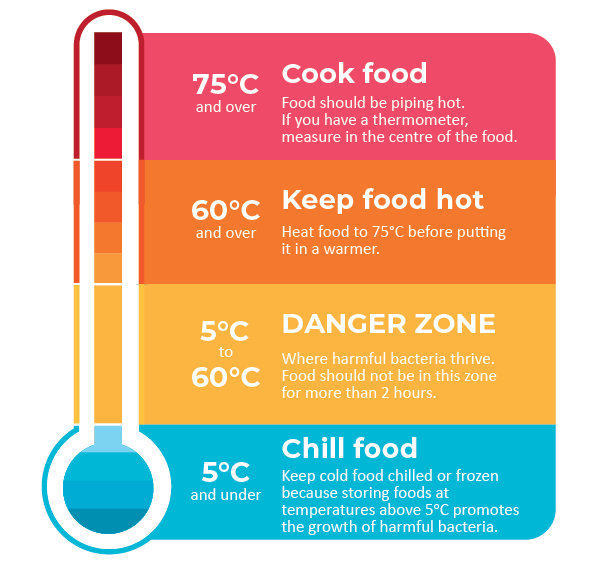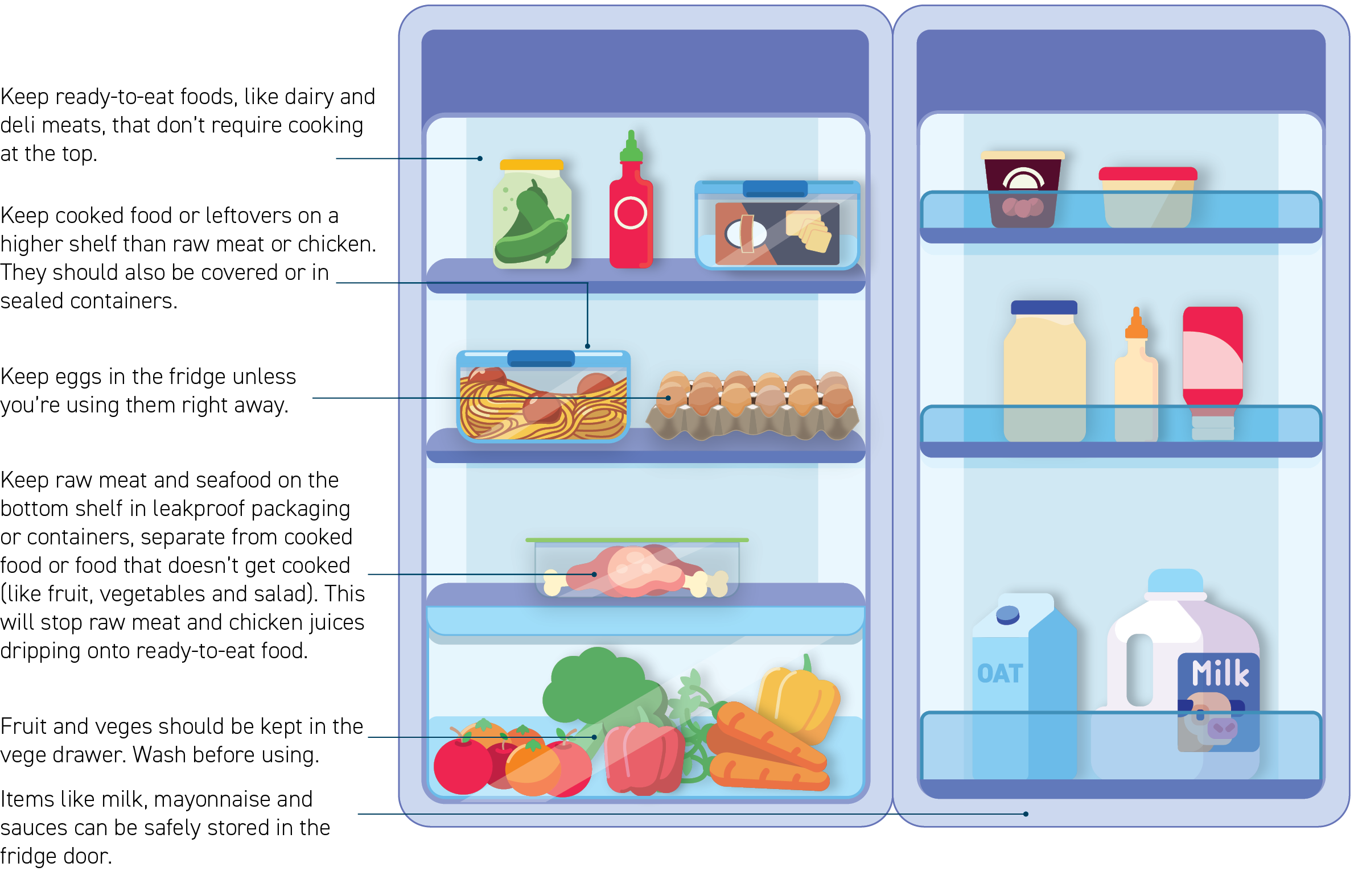How to prevent food poisoning
Every year, thousands of New Zealanders get food poisoning. Many of these cases are due to poor food handling, preparation, cooking, or storage in the home.
Food can carry harmful bacteria and viruses that can make you sick. This is known as foodborne illness (or food poisoning). You can help keep your family from getting sick by following the advice on this page on:
- preparing food
- cooking food
- storing and using leftover food
- storing food in your fridge
- transporting food
Download a copy of our 'Food safety at home' booklet [PDF, 1.1 MB]
Preparing, cooking, storing, and transporting food
The following tips will help prevent you and your family getting food poisoning.
Preparing food
- Handwashing is one of the best ways to prevent foodborne illness. Wash your hands with soap and clean water, and dry them well before handling, cooking, and eating food.
- Use clean eggs. Wipe them with a paper tower to make sure they are free from dirt, faecal matter, and cracks. Wash your hands on both sides using clean, soapy water for at least 20 seconds. After handling eggs, also thoroughly wash preparation surfaces, dishes, and utensils with hot soapy water, then rinse and dry them.
- Whether you’ve grown them yourself or bought them at the store, wash and dry fresh fruit and vegetables, and remove any damaged areas before eating – especially if you are having them raw.
- Defrost frozen foods thoroughly so they will cook properly in the middle. If the packaging says you can cook the food directly from frozen, make sure you follow the cooking instructions. Defrost food in your fridge or use the defrost setting on your microwave. Ensure juices from defrosting meat and packaging can’t spread to other food, utensils, or surfaces.
- Raw meat and its juices can carry germs that make you sick. These can transfer to your hands, chopping boards, cooking utensils, bowls, plates, and other food you’re preparing. This is called “cross-contamination”.
- Don’t wash raw meat, especially chicken, before cooking. Washing it doesn’t remove germs, instead it spreads them to your sink and kitchen surfaces, where they can contaminate other food. If you want, pat the meat dry with a paper towel, throw the paper towel straight into a waste bin, and wash your hands before handling other food.
- To prevent cross-contamination, use different chopping boards for raw meat, seafood, and ready-to-eat foods like salads and cheese. If you have only one chopping board and have used it to prepare raw meat or seafood, wash it in hot, soapy water, and dry it well before using it for other food. The same applies for utensils, plates, or bowls used for preparing and serving food.
Cleaning tips
-
Wash your cloths regularly: Try to use clean cloths every day for washing and drying the dishes. Dirty cloths can spread germs onto your hands, other dishes and utensils, and throughout your kitchen.
-
Microwave your sponges: Cloths or sponges used to wash dishes can be sanitised by placing them wet in a microwave on high for 3 to 4 minutes. The heat will kill off bacteria and viruses. Sponges with a metal or steel mesh should not be microwaved.
-
Clean as you go: To minimise cross-contamination, wash your work surfaces, utensils, chopping boards, and plates and bowls with hot soapy water as you go. If you’re using a surface spray, choose one that’s specifically labelled for food-preparation areas, and follow the manufacturer’s instructions on contact time, rinsing and drying.
Cooking food
You and your family can get food poisoning from undercooking certain foods – particularly chicken, other meats and seafood. This is because harmful germs can be on these foods.
Cooking your food at the right temperature and, importantly, for the right amount of time, helps to kill harmful germs. Food packaging usually contains useful cooking instructions.

- Ensure poultry is cooked right through to kill harmful germs. Chicken juices should run clear, and the meat should not be pink in the middle, although it can remain a little pink in colour close to the bone.
- Pork should also be cooked right through.
- When meat is minced, surface germs get mixed through the product. So, thorough cooking is needed for minced meat products such as beef, pork, chicken, and lamb burgers; sausages, including saveloys and cheerios; dumplings; and chicken nuggets. Cook meat all the way through, until juices run clear.
- Convenience foods that contain minced meat might look cooked, but the meat in the centre could still be undercooked. In particular, take extra care with frozen products like chicken nuggets, chicken kievs, or dumplings.
- If you have a meat thermometer, use it to check temperatures in the middle of the thickest part of the meat you’re cooking. The meat should be cooked to a temperature of 75°C for 30 seconds, 70°C for 3 minutes, or 65°C for 15 minutes. If you don’t have a thermometer, cook meat until any juices run clear and it is piping hot.
- To prevent cross-contamination, use one set of utensils, plates, or bowls for raw meat and chicken, and another set for cooked food. If you have only one set, wash them in hot, soapy water and dry well before using for cooked or other food.
- Eggs should be cooked until the white is completely firm and the yolk begins to thicken.
- Defrost frozen foods thoroughly in the fridge or microwave so they cook properly in the middle. Or, follow cooking instructions on labels or packaging that say you can cook the food directly from frozen.
- Reheat leftovers until piping hot (over 75°C). Warm doesn’t kill bacteria. Hot does. Don't reheat your leftovers more than once.
- Check the use-by dates on food packaging. Foods with use-by dates can become unsafe to eat before they are visibly spoiled or off. Don't buy, eat or drink products once this date has passed because they could make you sick.
- If food is labelled with a best-before date, it's okay to eat the food after the date has passed, as long as the food is not showing signs that it's gone “off”. Smell it and look for signs of decay or mould. If in doubt, throw it out.
Storing and using leftover food
- Refrigerate or freeze leftovers as soon as possible or within 2 hours of cooking. The hotter the weather, the shorter the time food will stay safe.
- Divide large portions of hot food into smaller containers or a shallow tray to help it cool quickly and evenly, and to stop harmful bacteria from growing to levels that could cause illness.
- Store leftovers in a covered container in your fridge.
How long you can keep leftovers
- Rice-based leftovers: Keep rice-based leftovers refrigerated and eat them within 2 days. These types of leftovers are risky because uncooked rice can contain bacterial spores that survive cooking. The spores then form bacteria, which produce toxins that cause food poisoning – and toxins are not destroyed by reheating.
- Cooked food eaten cold: Leftovers of cooked meals that are normally eaten without reheating – like pasta salads, roast vege salads, or potato salads – should be refrigerated and eaten within 2 days.
- Leftovers eaten hot: Keep them refrigerated and eat them within 4 days. Reheat until piping hot before eating.
- Leftover green salads: Eat salads containing raw leafy greens as soon as you can after preparation. Use any leftover salad as ingredients in cooked dishes - like soups and stews - or throw them out. Leafy greens can carry illness-causing bacteria that survive or grow in the fridge.
- When in doubt, throw it out.
Reheating leftovers
- Reheat leftovers until piping hot (over 75°C). Warm doesn’t kill bacteria. Hot does.
- Defrost frozen leftovers in the fridge or microwave. Leaving meals on a bench top to defrost allows harmful bacteria to grow.
- Don't reheat your leftovers more than once.
STORING FOOD IN YOUR FRIDGE
Most harmful germs can’t grow at low temperatures. Set your fridge temperature between 2°C and 5°C and follow these tips.

- Keep raw and cooked foods separate in the fridge.
- Check that your fridge door seals properly. If it doesn’t, cold air can escape and affect the temperature of food inside.
- Keep your fridge clean. Wipe up spills immediately. Wash surfaces with hot, soapy water, and dry thoroughly with a clean cloth. Even though most germs don’t like the cold, some will still grow over time.
- Don’t overfill your fridge as this can stop cold air from circulating properly and keeping your food nice and cold.
- Whether it’s in the fridge or in the cupboard, it’s best to store your food covered. Keep it in containers with tight-sealing lids if you can.
Transporting food
- When getting your groceries, pack raw meat and poultry in separate bags to other foods. This prevents the meat juices from dripping onto other raw and ready-to-eat foods, and onto food packages.
- Wash or replace reusable grocery bags frequently – or right away if you think meat juices have spilled on them.
- Take food straight home after shopping – especially raw meat, seafood, and chilled and frozen foods.
- Don’t leave groceries in a hot car, car boot or in direct sunlight from windows.
- If you can’t take them straight home or if the weather is hot, pack groceries in a chilly bag or bin with an ice pack. Transfer them to the fridge or freezer as soon as you get home.
Other food safety tips
For more tips to help you make sure your food is safe (it won’t make you sick) and suitable (the ingredients and condition are what you expect them to be) read more here:
Shopping with reusable bags and containers
Washing your hands before handling food
Food safety advice during bird flu outbreaks – Fact sheet [PDF, 303 KB]
Food additives and preservatives
Food safety during pregnancy
When you're pregnant, your levels of immunity are lower than usual, so you're more at risk of getting diseases carried by food.
Find out how to prepare food safely during pregnancy
Food safety for people with low immunity
People with low immunity can be at higher risk of getting food poisoning. It can also be more dangerous for them. We’ve got advice on this.
Get food safety advice for people with low immunity
Symptoms of food poisoning
Food can carry harmful bacteria and viruses that can make you sick. The most common of these are Campylobacter, Norovirus, Salmonella, Yersinia, and some E. coli.
Less commonly, you can also get sick from eating food when it carries fungi, parasites, toxins, and natural contaminants.
Common symptoms of food poisoning include:
- nausea or vomiting
- diarrhoea (which can be bloody)
- allergic reactions
- headaches
- stomach cramps or pains
- fever or chills
- muscle or joint aches.
Symptoms may show up in as little as 20 minutes or they could take several weeks.
If you or your family have any of these symptoms, contact a doctor.
Find out more about symptoms and causes of food poisoning
Who to contact
If you have questions about food safety at home, email info@mpi.govt.nz








